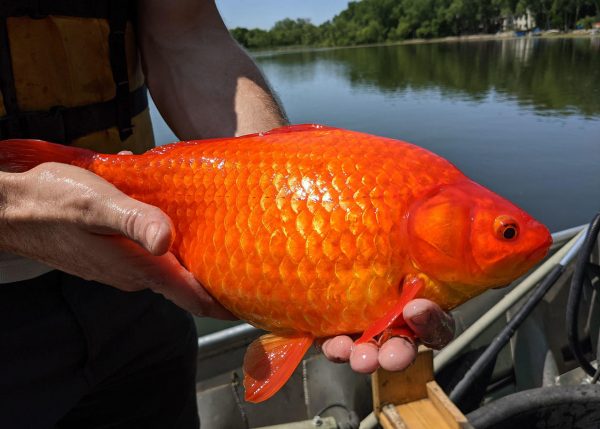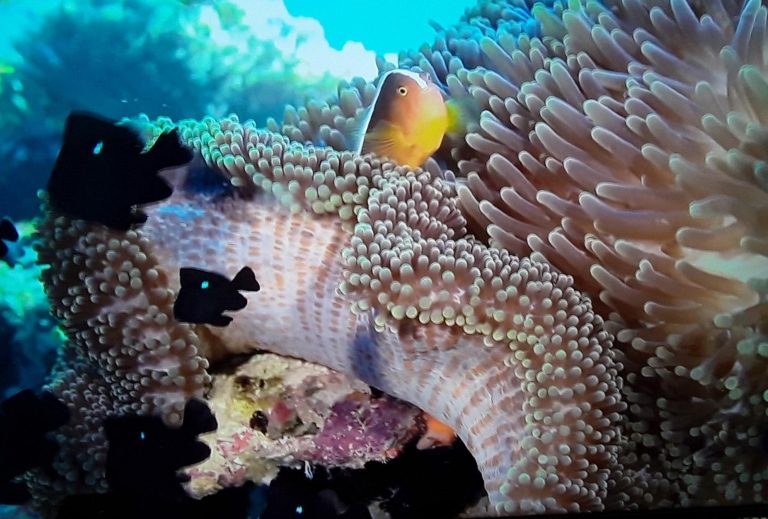Pet goldfish released into natural bodies of water are causing problems around the world. Their growing population has generated concern in Minnesota, Virginia and Washington states, Australia, Canada, and other areas, according to USA Today.
Minnesota officials have warned people not to release goldfish into the wild after finding a large number of giant goldfish in a local lake.
A fishy origin
The history of goldfish goes back 1,000 years to ancient China, where they were first selectively bred for their golden hue. There, they were considered a “symbol of good fortune and luck.”
With around 200 beautiful varieties to choose from, goldfish make an ideal first-time pet for children and for those who do not have the circumstances for keeping other animals. Goldfish have at least a three month memory. Their visual acuity allows them to distinguish individuals.
Today, the deep orange scaled goldfish that we are familiar with are so common that they are virtually disposable. When an owner decides it’s time to try something new, the goldfish is released into a neighboring lake, pond, or river. According to experts, the decision may be well-intentioned, but it is a foolhardy thing to do.
Success
You are now signed up for our newsletter
Success
Check your email to complete sign up
Most people do not realize that a small pet goldfish can wreak havoc in the wild. As a member of the carp family, goldfish quickly reproduce and may even survive on minimal oxygen during the winter months.
Przemek Bajer, owner of Carp Solutions and a research assistant professor at the University of Minnesota noted, “If you have a lot of goldfish and carp in the lake, usually the first thing that happens is all the aquatic plants disappear.”
Monstrous fish in Burnsville, Minnesota
Burnsville, Minnesota officials tweeted that the city recently found large groups of goldfish in Keller Lake. It is suspected that pet owners let a few into the lake, causing a population boom. City officials posted photos of the giant goldfish the size of dinner plates found in Lake Keller, weighing around four pounds.
The city is now begging residents to consider giving unwanted goldfish to a friend, rather than dumping them in public waterways.

“Instead of releasing your pet goldfish in a local lake or pond, please consider other options for finding them a new home like asking a responsible friend or neighbor to care for it,” the city of Burnsville said in a Facebook post.
Burnsville natural resources specialist Caleb Ashling said, “We had some reports from residents of some increasingly large groups of goldfish out on the lake. Folks were seeing them from shore, or if they were out kayaking, they would catch a glimpse of them when they were out in their boat.”
Dealing with the problem
The city of Burnsville has teamed up with Apple Valley and Carp Solutions to scan Keller Lake for invasive goldfish and other species. Ten huge goldfish in the first weeks were recovered from lake Keller and 18 more in the second week, according to Associated Press.
The city of Chaska, Minnesota recently adopted a three-year strategy to control invasive species to keep them out of the Minnesota River. Big Woods Lake is “mostly goldfish,” according to WSB and Associates’ Jordan Wein. Together with his team they are electroshocking the fish to learn more about them.
Wein said, “That power sends some electricity into the water and it stuns the fish momentarily.” Netters then scoop up what they are looking for. Tim Sundby of Carver County Water Management told CBS Minnesota,“last fall we removed close to 100,000 goldfish.”
In the city’s three-year plan, the crew will capture, tag, and release the fish. Scientists will then be able to monitor their movements.
One ‘fish story’ after another
Goldfish are typically 7 to 16.1 inches long, but may reach five pounds in the wild. They may live for five to ten years as a pet but can live up to 25 years in nature. The oldest goldfish ever documented was 43 years old.
These fish are resilient, hardy and have voracious appetites.
One fisherman in Syracuse, New York, claimed to have captured a goldfish 14 inches long in early 2021.
In 2019, a Kentucky man captured a 20-pound goldfish.
In Virginia, a 3 pound, 9 ounce goldfish was recently caught in Hunting Creek, a tributary of the Potomac River.
According to Wink News, the Missouri Department of Conservation posted a picture of fisherman Tim Owings with a 9-pound catch. The huge butterfly koi goldfish was captured at Blue Springs Lake Remembrance.
Ashling and his Burnsville colleagues are still assessing the fish survey; they hope their discoveries will prevent pet owners from ditching their goldfish into public waterways.
Meanwhile, The U.S. Fish and Wildlife Service posted instructions on “how to break up with your goldfish,” saying pet owners “may be horrified to learn that under the right conditions it will survive and grow. And grow. Like, really BIG.”
















